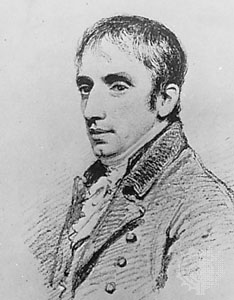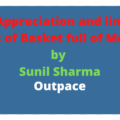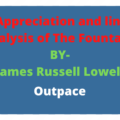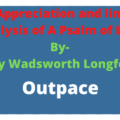About the poet

William Wordsworth was one of the finest English Romantic poets who, with Samuel Taylor Coleridge, helped to launch the Romantic Age in English literature with their joint publication Lyrical Ballads (1798). Born on April 7, 1770, Wordsworth’s magnum opus is generally considered to be The Prelude, a semiautobiographical poem of his early years that he revised and expanded the number of times. It was posthumously titled and published by his wife in the year of his death, before which it was generally known as “the poem to Coleridge”.
The second of five children born to John Wordsworth and Ann Cookson, William Wordsworth was born on 7 April 1770 in what is now named Wordsworth House in Cockermouth, Cumberland, part of the scenic region in northwestern England known as the Lake District. William’s sister, the poet and diarist Dorothy Wordsworth, to whom he was close all his life, was born the following year, and the two were baptised together. They had three other siblings: Richard, the eldest, who became a lawyer; John, born after Dorothy, who went to sea and died in 1805 when the ship of which he was captain, the Earl of Abergavenny, was wrecked off the south coast of England; and Christopher, the youngest, who entered the Church and rose to be Master of Trinity College, Cambridge. After the death of Wordsworth’s mother, in 1778, his father sent him to Hawkshead Grammar School in Lancashire (now in Cumbria) and sent Dorothy to live with relatives in Yorkshire. She and William did not meet again for another nine years.
Wordsworth made his debut as a writer in 1787 when he published a sonnet in The European Magazine. That same year he began attending St John’s College, Cambridge. He received his BA degree in 1791. He returned to Hawkshead for the first two summers of his time at Cambridge, and often spent later holidays on walking tours, visiting places famous for the beauty of their landscape. In 1790 he went on a walking tour of Europe, during which he toured the Alps extensively, and visited nearby areas of France, Switzerland, and Italy.
In November 1791, Wordsworth visited Revolutionary France and became enchanted with the Republican movement. He fell in love with a French woman, Annette Vallon, who, in 1792, gave birth to their daughter Caroline. Financial problems and Britain’s tense relations with France forced him to return to England alone the following year. The circumstances of his return and his subsequent behaviour raised doubts as to his declared wish to marry Annette. However, he supported her and his daughter as best he could in later life. The Reign of Terror left Wordsworth thoroughly disillusioned with the French Revolution and the outbreak of armed hostilities between Britain and France prevented him from seeing Annette and his daughter for some years.
It was also in 1795 that he met Samuel Taylor Coleridge in Somerset. The two poets quickly developed a close friendship. For two years from 1795, William and his sister Dorothy lived at Race down House in Dorset—a property of the Pinney family—to the west of Pilsdon Pen. They walked in the area for about two hours every day, and the nearby hills consoled Dorothy as she pined for the fells of her native Lakeland. She wrote,
“We have hills which, seen from a distance almost take the character of mountains, some cultivated nearly to their summits, others in their wild state covered with furze and broom. These delight me the most as they remind me of our native wilds.”
In 1797, the pair moved to Alfoxton House, Somerset, just a few miles away from Coleridge’s home in Nether Stowey. Together Wordsworth and Coleridge (with insights from Dorothy) produced Lyrical Ballads (1798), an important work in the English Romantic movement. The volume gave neither Wordsworth’s nor Coleridge’s name as author. One of Wordsworth’s most famous poems, “Tintern Abbey”, was published in this collection, along with Coleridge’s “The Rime of the Ancient Mariner”. The second edition, published in 1800, had only Wordsworth listed as the author, and included a preface to the poems. It was augmented significantly in the next edition, published in 1802. In this preface, which some scholars consider a central work of Romantic literary theory, Wordsworth discusses what he sees as the elements of a new type of verse, one that is based on the ordinary language “really used by men” while avoiding the poetic diction of much 18th-century verse. Wordsworth also gives his famous definition of poetry as “the spontaneous overflow of powerful feelings: it takes its origin from emotion recollected in tranquillity”, and calls his own poems in the book “experimental”. A fourth and final edition of Lyrical Ballads was published in 1805.[
In 1802, Lowther’s heir, William Lowther, 1st Earl of Lonsdale, paid the £4,000 owed to Wordsworth’s father through Lowther’s failure to pay his aide. It was this repayment that afforded Wordsworth the financial means to marry. On 4 October, following his visit with Dorothy to France to arrange matters with Annette, Wordsworth married his childhood friend Mary Hutchinson. Dorothy continued to live with the couple and grew close to Mary. The following year Mary gave birth to the first of five children, three of whom predeceased her and William:
Wordsworth remained a formidable presence in his later years. In 1837, the Scottish poet and playwright Joanna Baillie reflected on her long acquaintance with Wordsworth. “He looks like a man that one must not speak to unless one has some sensible thing to say. However, he does occasionally converse cheerfully & well; and when one knows how benevolent & excellent, he is, it disposes one to be very much pleased with him.”
In 1838, Wordsworth received an honorary doctorate in Civil Law from the University of Durham and the following year he was awarded the same honorary degree by the University of Oxford, when John Keble praised him as the “poet of humanity”, praise greatly appreciated by Wordsworth. (It has been argued that Wordsworth was a great influence on Keble’s immensely popular book of devotional poetry, The Christian Year (1827)). In 1842, the government awarded him a Civil List pension of £300 a year.
Following the death of Robert Southey in 1843 Wordsworth became Poet Laureate. He initially refused the honour, saying that he was too old, but accepted when the Prime Minister, Robert Peel, assured him that “you shall have nothing required of you”. Wordsworth thus became the only poet laureate to write no official verses. The sudden death of his daughter Dora in 1847 at age 42 was difficult for the aging poet to take and in his depression, he completely gave up writing new material.
William Wordsworth died at home at Rydal Mount from an aggravated case of pleurisy on 23 April 1850, and was buried at St Oswald’s Church, Grasmere. His widow, Mary, published his lengthy autobiographical “Poem to Coleridge” as The Prelude several months after his death. Though it failed to interest people at the time, it has since come to be widely recognised as his masterpiece.
About the poem
William Wordsworth being a true nature lover, was overawed by the glory, silence and unexplainable grandeur that nature has offered to him. The poem revolves around the time when the speaker visited London and its breathtaking view caught his attention. The poet is crossing the Westminster Bridge in London (Westminster Bridge is a road and foot traffic bridge stretching over the River Thames, linking Westminster and Lambeth) at the crack of dawn and is amazed by the serenity and tranquility of the city. Not that he had never seen other beautiful places before but London is one of the many places that has caught the attention of many poets – Wordsworth being one of them. The bridge being a merger between the rich and the poor region of the city, made the port fall head over heals in love with the city.
Background of the poem
The background of the poem stands on a simple yet very powerful thought – Nature vs. Civilization. Standing on the Westminster Bridge, contemplating the fresh sunlight and breeze of early-morning London, making the poet finally declare that he had found the most beautiful place on earth. He found London to be wearing the morning’s beauty like a fine shirt or cape. The time is so early in the morning that everything seemed to be dead silent along with no London fog to obscure the view. The poet was so astonished to have felt the serene breeze of an early London city that he compares its calmness with Nature’s.
Structure of the poem
Earth has not anything to show more fair:
Dull would he be of soul who could pass by
A sight so touching in its majesty:
This City now doth, like a garment, wear
The beauty of the morning; silent, bare,
Ships, towers, domes, theatres, and temples lie
Open unto the fields, and to the sky;
All bright and glittering in the smokeless air.
Never did sun more beautifully steep
In his first splendour, valley, rock, or hill;
Ne’er saw I, never felt, a calm so deep!
The river glideth at his own sweet will:
Dear God! the very houses seem asleep;
And all that mighty heart is lying still!
Composed upon Westminster Bridge, September 3, 1802″ is an Italian sonnet, written in iambic pentameter with ten syllables per line. The rhyme scheme of the poem is abbaabbacdcdcd. The poem was actually written about an experience that took place on July 31, 1802 during a trip to France with Wordsworth’s sister, Dorothy Wordsworth.
There are a few literary devices in the poem Composed Upon Westminster bridge by William Wordsworth. These include:
- Assonance – Assonance is the repetition of vowel sounds in the same line.
- The sound of /o/ in “Dull would he be of soul who could pass by.” (Line 2)
- The sound of /I / in “All bright and glittering in the smokeless air”. (Line 8)
- Consonance – Consonance is the repetition of consonant sounds in the same line.
- The sound of /l/ in “splendour, valley, rock, or hill;” (Line 10)
- The sound of /h/ in “And all that mighty heart.” (Line 14)
- The sound of /s/ in “Ships, towers, domes, theatres, and temples lie.” (Line 6)
- Enjambment – It is defined as a thought in verse that does not come to an end at a line break; instead, it rolls over to the next line.
Line 2 – 3
Dull would he be of soul who could pass by
A sight so touching in its majesty.
- Hyperbole – Hyperbole is a device used to exaggerate a statement for the sake of emphasis. Wordsworth has used this device in the opening lines poem as he exaggerates about the beauty of London city.
Line 1 – 2
Earth has not anything to show more fair:
Dull would he be of soul who could pass by
.
- Imagery – Imagery is used to make readers perceive things involving their five senses.
- The river glideth at his own sweet will. (Line 12)
- This City now doth, like a garment, wear. (Line 4)
- Personification – Personification is to give human qualities to inanimate objects.
Line 4
This City now doth, like a garment, wear. Here, this city is personified.
- Simile – It is a figure of speech used to compare an object or persons with something else to make the meanings clear to the readers.
- This City now doth, like a garment, wear. (Line 4) Here, the city has been compared to the garment
- Alliteration – Alliteration is the conspicuous repetition of identical initial consonant sounds in successive or closely associated syllables within a group of words, even those spelled differently.
- A sight so touching in its majesty: (Line 3)
- Ships, towers, domes, theatres, and temples lie (Line 6)
- Open unto the fields, and to the sky; (Line 7)a
- All bright and glittering in the smokeless air. (Line 8)
- And all that mighty heart is lying still! (Line 14)
- Ne’er saw I, never felt, a calm so deep! (Line 11)
Theme of the poem
The theme of the poem revolves around the solitary city life in the break of dawn. The poet compares the silence to the silence and calmness that this beautiful nature radiates. The poet considers himself lucky to wake up early in the morning, standing by Westminster bridge and feel the breeze and silence of the otherwise honking city life. The poem, therefore, celebrates the beauty of man-made creations and structures.






